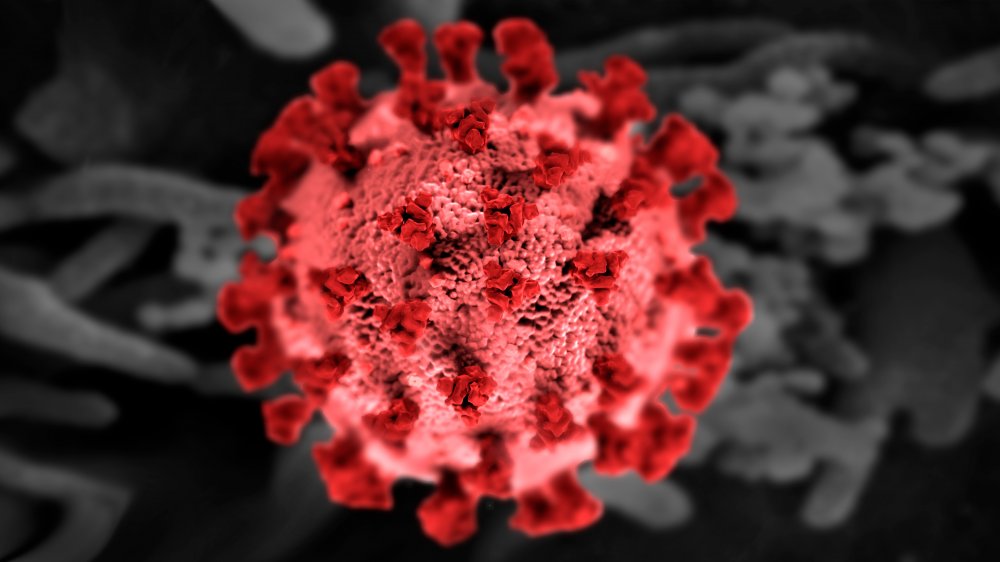The Messed Up History Of SARS
According to the World Health Organization, SARS (Severe Acute Respiratory Syndrome) is "a viral respiratory disease caused by a SARS-associated coronavirus." It was first discovered in February 2003 in Asia. Per the CDC, "the illness spread to more than two dozen countries in North America, South America, Europe, and Asia before the SARS global outbreak of 2003 was contained," and by the end of the ordeal, over 8,000 people had become sick, with 774 deaths. The CDC also notes that, since 2004, no new cases have been reported — so far.
Symptoms of SARS are similar to the flu. They include fever, headache, body aches, and, eventually, a dry cough, with most patients developing pneumonia. SARS is spread via close contact between individuals, most often from droplets expelled when an infected person sneezes or coughs. Touching a surface contaminated with SARS and then touching one's eyes, nose, or mouth can also bring about infection. It can also spread through the air.
How is the coronavirus that causes SARS different from the one that causes COVID-19? Per Healthline, "the virus that causes SARS is known as SARS-CoV, while the virus that causes COVID-19 is known as SARS-CoV-2." Coronaviruses "are a very diverse family of viruses" with "a large host range, which includes humans." Both SARS-CoV and SARS-CoV-2 are thought to have originated in bats. The "coronaviruses that make the jump to human hosts can cause serious illness" for a variety of reasons, including humans' lack of immunity to the virus.
How do SARS and COVID-19 differ?
The viruses that cause SARS and COVID-19 share similarities, though SARS cases were more extreme than those of COVID-19. As Healthline reports, "20 to 30 percent" of those infected with SARS needed mechanical ventilation, while only a small number of COVID-19 patients have required similar treatment. There are higher mortality rates in SARS (10 percent) versus COVID-19 (estimated at 0.25 to 3 percent).
COVID-19 is spread much more easily than SARS, seemingly because "the amount of virus, or viral load, appears to be highest in the nose and throat of people with COVID-19 shortly after symptoms develop" as opposed to SARS's viral load peaking later in the illness. COVID-19 can be spread by someone showing no symptoms, which is not true of SARS. The bottom line is, "COVID-19 may be more challenging to contain because the virus that causes this disease spreads more easily and often causes mild symptoms."
In a 2007 review of the book SARS: How a global epidemic was stopped, the Bulletin of the World Health Organization reviewed three especially relevant lessons to be learned from the containment of the SARS and applied to other pandemic situations. First, "transparency is the best policy." Some countries "did not acknowledge openly and squarely the presence of SARS, downplayed its extent, and attempted to prove that it was something else." Governments must treat an outbreak like the serious, dangerous event that it is in order to have a safer, well informed constituency.
What lessons can we learn from SARS?
Second, scientists around the world came together to in "unprecedented collaboration," working together to identify the virus and develop diagnostic tests, as posted on the website of the National Center for Biotechnology Information. This "openness and willingness to share critical scientific information promptly" rather than countries working solo, or even competing with other countries, meant "the virus responsible was identified and its genome mapped within weeks of the outbreak."
Third, "animal husbandry and marketing practices seriously affect human health." SARS-CoV has been thought to originate in animals since its discovery in 2003. This is also true of other coronaviruses that affect humans and cause COVID-19 and MERS. This means "old and unhygienic veterinary practices must be discarded or the public health risk from zoonotic diseases will always be with us." This advice seems particularly useful when it comes to controlling avian influenza, also known as H1N5, or "bird flu," which in 2007 the reviewer called "the single biggest public health threat the world faces right now." There have been zero cases of bird flu reported to the World Health Organization in 2020. The total numbers of cases and deaths stand at 861 and 455, respectively. Like SARS, H1N5 is seemingly under control — for now.


